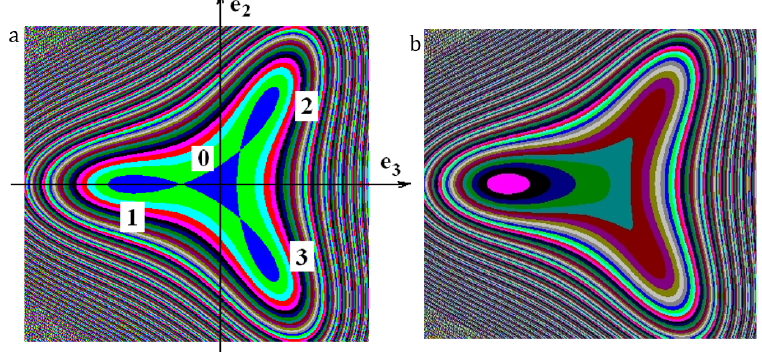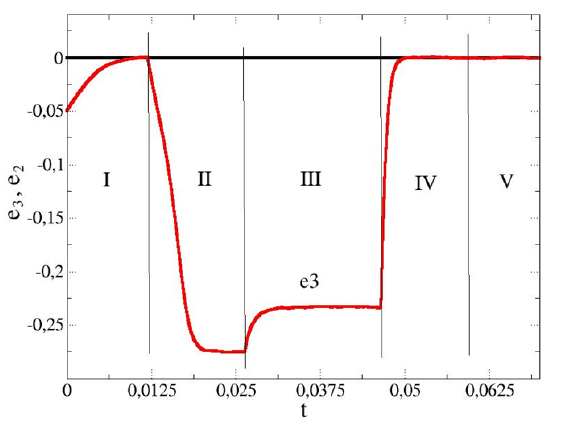- Submissions

Full Text
Research & Development in Material Science
Computer Simulation of Martensitic Phase Transitions Caused by Plastic Deformation and Laser Exposure
Metlov LS1,2*, Blinova EN3 and Libman MA3
1Donetsky Institute of Physics and Technology named after A.A. Galkin, Russia
2Donetsk National University, Ukraine
3Bardin Central Research Institute for Ferrous Metallurgy, Moscow, 105005, Russia
*Corresponding author:Metlov LS, Donetsky Institute of Physics and Technology named after A.A. Galkin, Russia
Submission: March 20, 2023;Published: April 12, 2023

ISSN: 2576-8840 Volume 18 Issue 3
Abstract
The paper carries out computer modeling of several stages of exposure to alloys prone to martensitic transitions, including the stages of mechanical (deformation) and thermal (laser) exposure. It demonstrates the possibility of the existence of a closed cycle, when, as a result of various influences, the material returns to its original state.
Keywords:Martensite; Austenite; Martensitic phase transitions; Order parameter; Chromium-nickel steels; Geisler alloys; Laser exposure
Opinion
Chromium-nickel and manganese alloys are have been subject to extensive research [1-7], in particular, in connection with tribological problems [3]. Depending on the chemical composition (component ratio) and temperature, chromium-nickel alloys may exist in a martensitic or austenitic state [7].
Recently, there was increasing scholarly interest to the creation of inhomogeneous structures in such alloys consisting of austenite regions formed by local laser action in the martensitic matrix [7-11]. Initially, the material, which was in the austenitic state after smelting and hot plastic deformation, was transferred to the martensitic state with the help of cold rolling (tensile force) with large degrees of compression. After some relaxation, the sample was subjected to local laser heating in the temperature range of reverse martensitic transformation, which transferred it back to the austenitic state. Then the sample was cooled to the initial temperature, while remaining in the austenitic state. The entire cycle of material transformations is possible if the initial temperature of the sample is in the region of coexistence of austenitic and martensitic phases.
Thus, the research task emerges to model these stages within one of the models of martensitic transitions. One of the authors has previously conducted several studies of fluctuation and relaxation processes in materials with shape memory effect, namely in Geisler alloys [12-15]. Taking into account the physical generality of the processes during martensitic transitions, it makes sense to use this model to study the above stages, which are also observed for chromium-nickel alloys.
For calculations, we select a set of model parameters given in [12-15]. It is important for us that for these parameters of the model, the temperatures of the forward and reverse martensitic transitions differ and are equal, respectively, to TM=150K and TA=156K, which provides a temperature range of 6K lability. It is important to emphasize that the values of the temperatures TM and TA, as well as the value of the lability interval, are not critical for modeling the process.
Figure 1a shows the relief of free energy for the temperature Teq=155K, for which potential pits of three martensitic minima (for each of the martensite orientations) and an austenitic one (in the center of the plane of the order parameters) have the same depth. As the initial temperature for computer simulation, we choose the temperature T=Teq=155K, at which the stability of the martensitic and austenitic phases are, in fact, the same. In addition, we assume that at the initial moment of time the sample is not in a strict minimum of free energy, but in some arbitrary state with a non-zero value of the order parameter. From this state in the process of evolution, the sample passes into the nearest minimum of free energy. When the task parameters are selected, they turn out to be the minimum corresponding to the austenitic state (the 0th minimum in Figure 1a). In Figure 2, where the dependence of the phase transition parameters (e3) on the time of the process is shown, this stage corresponds to region I.
Figure 1:Relief of free energy: a) in the absence of a tensile force b) when stretching the sample.

Figure 2:Evolution of order parameters at various stages of exposure to the sample.

At the time of 0.0125conl. units, an external tensile force is activated, directed towards the 1st minimum of free energy. Taking into account this force leads to a change in the relief of free energy (Figure 1b). All minima of free energy, except for the 1st, are suppressed, and the remaining minimum increases (deepens). Naturally, in the process of evolution, the system slides into this minimum (region II in Figure 2). A martensitic state induced by an external tensile force occurs in the system.
If the external force is turned off at a time slightly above 0.025cont. units, then the system relaxes to the nearest 1st minimum of free energy. Since this minimum is less deep, this leads to a decrease in the absolute value of the parameter of the order e3 (region III in Figure 2). If at some point in time the laser heating is turned on above the temperature TA, the system will begin to evolve to the austenitic state with e3=0 (region IV in Figure 2). Further cooling to the initial temperature leaves the austenitic state unchanged (region V in Figure 2)
Thus, as a result of a closed cycle, the material returns to its initial stable state corresponding to its state at the boundary of regions I and II. Further repetition of the sequence of actions with the same result can be carried out indefinitely. A sufficiently small volume of material was chosen to simulate this cycle, so that the whole process proceeds homogeneously. If the volume of the material is large, then the possibility of local laser beam exposure to its individual sections and the formation of an inhomogeneous structure opens up.
References
- Efros BM, Berezovskaya VV, Konakova IP, Beigelzimer YE, Efros NB (2000) FTVD 10(3): 28.
- Efros NB, Pilyugin VP, Efros BM, Patselov AM, Chernyshev EG, et al. (2004) FTVD 14(3): 82.
- Deryagin AI, Zavalishin VA, Sagaradz VV, Zavalishin VA, Varyukhin VN (2005) Russian Metalurgy 6: 478.
- Efros BM, Pilyugin VP, Patselov AM, Gladkovskii SV, Efros BM, et al. (2006) In book: Zhu YT, Varyukhin V (Eds.), nanostructured materials by high-pressure severe plastic deformation, pp. 121-126.
- Linderov ML (2017) Identification of mechanisms and kinetics of stress relaxation during deformation of model trip/twip steels by the method of cluster analysis of acoustic emission.
- Finkel VM (1977) Physical foundations of fracture inhibition. Metallurgy, Moscow, Russia.
- Blinova EN, Libman MA, Petrovsky VN, Pimenov EV, Umnov PP, et al. (2021) The effect of laser treatment on the strength characteristics of the γ-phase in Fe-Cr-Ni alloys. Izvestiya RAS. The Series is Physical. 85(7): 984-989.
- Galkin MP, Libman MA, Estrin EI (2014) Using phase transformations to create gradient materials. Materials Science (3): 25-28.
- Andreev AO, Galkin MP, Libman MA, Mironov VD, Petrovsky VN, et al. (2014) Application of laser heat treatment to create gradient materials based on the Fe-Cr-Ni system. MiTOM (1): 50-53.
- Blinova EN, Glezer AM, Libman MA, Estrin EI (2014) Structure of the marten-site-austenite transition zone after a local pulse heating of the martensite. Russian Physics Journal 57(4): 429-435.
- Blinova EN, Libman MA, Petrovsky VN, Pimenov EV (2021) Principles of creating materials with spatial distribution of macroscopic regions with different physical and mechanical properties. Steel (11): 46-49.
- Metlov LS (2019) FTVD 29(1): 28.
- Metlov LS, Poymanov VD (2018) FTVD 28(1): 62.
- Metlov LS, Koledov VV, Shavrov VG, Yu V Techtelev, Petrenko AG (2021) FTVD 31(2): 28.
- Metlov LS, Koledov VV, Shavrov VG (2018) FTVD 28(1): 46.
© 2023 Metlov LS. This is an open access article distributed under the terms of the Creative Commons Attribution License , which permits unrestricted use, distribution, and build upon your work non-commercially.
 a Creative Commons Attribution 4.0 International License. Based on a work at www.crimsonpublishers.com.
Best viewed in
a Creative Commons Attribution 4.0 International License. Based on a work at www.crimsonpublishers.com.
Best viewed in 







.jpg)






























 Editorial Board Registrations
Editorial Board Registrations Submit your Article
Submit your Article Refer a Friend
Refer a Friend Advertise With Us
Advertise With Us
.jpg)






.jpg)














.bmp)
.jpg)
.png)
.jpg)










.jpg)






.png)

.png)



.png)






